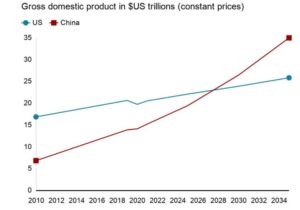
The Next “Normal.” What are the Key Factors that Business Leaders Should Keep in Mind as 2021 Unfolds?
The economic and social upheaval caused by the global pandemic is devastating. Political, environmental and health challenges mean that business has adapted quickly to meet the challenges of a ‘new normal.’ But what is the next ‘normal?
The past century is a good reference point to determine the future. British statesman and Prime Minister (1940–45, 1951–55) Winston Churchill wrote:
“Those that fail to learn from history are doomed to repeat it.”
Reviewing history may not predict the future but it will certainly provide valuable insights. In the 20th Century alone we endured two world wars, the Spanish influenza, the Great Depression, and the Global Financial Crisis. This list is not definitive. What is certain is that Covid 19 has ushered in changes that were part of the plan for a distant normal. These changes are now the norm. The next normal will depend on how businesses continue to remain agile, resilient and adaptable in forward trends and challenges.
Digital Transformation
Covid 19 has swiftly steered a digital transformation. Concepts such as work from home (WFH), virtual offices, online commerce and process automation have been accelerated beyond what was thought possible in a short amount of time.
With a predicted 80 percent of revenue growth coming from digital offerings in the future, it will be essential for businesses to invest in key enablers such as integrated cloud platforms, agile working, intelligent automation, AI, blockchain and advanced data and analytics according to Guy Holland (KPMG Digital Delta and Technology Advisory).
Whilst digital transformation is accelerating, the most important focus for business transformation will still be Customer-Centricity. Consumer behaviours changed rapidly during the pandemic and it is unlikely that these behaviours will return to pre-Covid trends. Holland states, that based on KPMG’s recent research, “customers are unlikely to return to their previous channel behaviour if they receive a great digital experience in this environment. Retaining this momentum, albeit delivered through serendipity, will deliver significant financial and operational benefits to organisations.”
A McKinsey survey published in October 2020 found that companies are three times likelier than they were before the crisis to conduct at least 80 percent of their customer interactions digitally.
Innovation
The growth in digitisation during the pandemic has also changed markedly in relation to healthcare. Telehealth and biopharma have accelerated to unprecedented levels. In April 2020 in Australia, the number of telehealth consultations rapidly expanded, to more than 700,000.
More than 4.3 Million health and medical services were delivered via telehealth since the Australian Government introduced the measure to stop the spread of Covid 19. This is a clear sign of the upscaling in digital transformation in this industry.
The new “Next” digitalisation of business is here to stay.
Education
Education underwent one of the most rapid changes, converting almost overnight to online learning for students. Teachers were catapulted into new systems and strategies to facilitate this change. It brought the role of teachers and education firmly into the minds and households of families. Hopefully with a greater appreciation of the work that is done in schools. The COVID-19 pandemic has fostered innovation into every education system around the globe. Based on a recent 59-country survey of educators and education administrators, Fernando Reimers and Andreas Schleicher note that: “The crisis has revealed the enormous potential for innovation that is dormant in many education systems.”
The key factor now in Education is sustainability. Bridging the gap between rich and poor, ensuring equality of access and support to already stretched and exhausted teachers. The future and relevance of education hinges on these factors.
China’s Recovery and Escalation
China, the first country to be hit by the pandemic is also the first to emerge from it with predictions that China’s economy will become the world’s largest by 2028, overtaking the US.
The UK-based Centre for Economics and Business Research (CEBR) states that China’s “skillful” management of Covid-19 will boost its economic recovery considerably in comparison to the US and Europe in future years.
United States and Chinese Economies (2010-2034)
Source: CEBR World Economic League Table 2021
Australia has also faired relatively well. Figures from the Australia Bureau of Statistics show that GDP grew 3.3 per cent in the September quarter as Covid 19 restrictions eased across most states and territories. Household consumption also grew by almost 8% after an earlier decline of 12.5 per cent in the previous quarter. The Reserve Bank Governor Philip Lowe states, that the economy should continue to grow but recovery will be “uneven and drawn out.”
There is hope for the Australian economy, yet many challenges still lie ahead and there is a lot of ground to make up, particularly in terms of the unemployment rate.
The Green Necessity
The threats to economic recovery are real and damaging. But in some ways the pandemic will accelerate productivity enhancing change in many areas. The downturn has led to economic adjustment, largely in relation to technology and changes in structures and practices, much of which will outlast the pandemic.
Lasting change in business is a certainty and it will also overlap and be amplified by the greater need to address climate change. One startling fact is that during Covid 19 the Himalayan peaks are visible for the first time in 30 Years.
A quick look at UNESCOs “Next Normal” campaign film highlights this necessity.
According to Kevin Sneader, the global managing partner at McKinsey & Company in an interview with HBR:
“The coronavirus is a shock with an immediate impact, but environmental change is a shock that has been building cumulatively. And business is going to be in the middle of the conversation as we talk about the green agenda in supply chains.”
Return to Work…?
The McKinsey Global Institute (MGI) estimates that more than 20 percent of the global workforce, most in highly skilled positions can work the majority of time away from the office and still be highly, if not more effective in their jobs.
It will be essential for businesses to consider how they will transition back, if at all.
According to CBREs Office Spaces Report, the vast majority of industries reduced their floorspace in 2020.
The mining sector is the only industry increasing its office footprint in Australia. The Financial Services sector, which includes the Big Four Banks accounts for 54 per cent of office space in capital city CBDs. Its floorspace was reduced by about 23, 000 square metres during the first 9 months of 2020. A fall of 17.5 per cent. The communications sector contracted the most, a 29 000 square metre reduction.
Whilst downsizing is the result of many factors, the increase in flexible working practices may see greater impacts on physical office space in the future.
Returning to the office shouldn’t be a matter of simply opening the door. Instead, it needs to be part of a systematic reconsideration of what exactly the office brings to the organization.
The other challenge has to do with adapting the workforce to the requirements of automation, digitization, and other technologies. Additionally, the clear and present danger of Zoom Fatigue is real.
These considerations are fundamental in transitioning to a new, next work environment.
Communication is the New Gold Standard
The American chocolate maker Milton S. Hershey put it this way more than a century ago, “business is a matter of human service.”
Human beings are social people, whose natural instinct is to communicate and congregate. Covid 19 restrictions challenged many and the ongoing mental health impact will be noticeable for years to come. Isolation brings its own unique issues. Loneliness, confusion, sleep deprivation, depressive symptoms. Businesses have a responsibility to ease workers back into the next normal.
Geoff Martha, CEO of Medtronic states:
We’ve already talked about more digitization. Another thing is that people are watching to see how companies treat their employees, customers, investors, and other stakeholders. Are they behaving in a socially responsible way? The younger generations, Gen Z in particular, will make future employment decisions in large part based on how companies are showing up in this pandemic. The social responsibility piece of this will have a direct impact on your ability to attract and retain top talent.
Clear and effective communication will play a vital role in business’ next normal with a focus on employees and wellbeing.
The Next Normal
The COVID-19 pandemic has been an economic and human catastrophe, and it’s far from over. With vaccines beginning to roll out, it’s possible to be cautiously optimistic that the next normal will emerge this year or next.
There are opportunities that need to be grasped readily in this new environment. Businesses should see these changes as an opportunity to radically reshape and restructure practices. This requires getting ahead of fast moving trends through digitization and designing operating models and unique structures that are flexible and resilient. At the heart of these disruptions and capitalisations is a human centred approach. Business progression is based on the premise that your audiences comprise of real people, whose perceptions are based on their HUMAN experiences. Employees, consumers and the wider community demand it. Now more than ever there is the need for authentic engagement.
Your Needs Are My Priority.
Let's Unlock the Power of Your Stories
CONTACT ME
I work closely with B2B and B2C companies providing useful and engaging content that converts viewers into customers.

Email me or call me at +61 413797729







